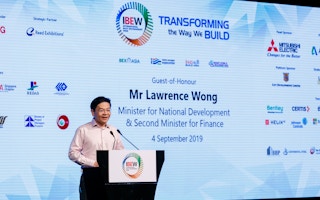Amid global trends of rapid urbanisation, digitalisation and climate change, the construction sector must transform itself to meet growing demand for infrastructure while reducing damage done to the environment.
The construction sector lags others when it comes to productivity and technology adoption, said experts at the inaugural International Built Environment Conference in Singapore last week.
But with regional demand for infrastructure holding strong, now is the time to play catch-up if Singapore’s built environment sector is to take advantage of opportunities, said Lawrence Wong, the city-state’s Minister for National Development, in his opening address.
The built environment is responsible for 39 per cent of global carbon emissions and 50 per cent, or 42.4 billion tonnes, of materials consumed every year. The latter will double by 2050, said Lisa Bate, chair of the World Green Building Council (WGBC).
“People take potshots at the aviation sector, which contributes 2 per cent of global emissions. You may say that those of us who are able to fly are an entitled bunch, but still when you look at where we can get big savings, the built environment is a large part to focus on,” she told an audience of industry professionals.
Bate added that technology is an enabler of transformation, and urged industry to look at digital solutions as a means to achieve sustainability goals.
The Building and Construction Authority (BCA) of Singapore, for instance, aims to have 80 per cent of constructed floor area in Singapore certified under its Green Mark green building scheme, up from 40 per cent today.
Speakers at the conference emphasised the potential of technology to enable more efficient resource use, improve productivity and even make jobs more attractive to the next generation of engineers—if the industry can resolve the challenges of digitalisation.
Collaboration across platforms
Interoperability, or ensuring that all partners can collaborate effectively while using different digital platforms, has been a major concern for industry. For instance, Building Information Modelling (BIM) creates digital 3D forms of construction projects that allow architects, engineers and construction professionals to collaborate on a project simultaneously. But different BIM software may produce models that are not compatible with one another, hindering collaboration.
“The interoperability of systems, platforms, digital tools, is a big challenge. Every (software) and hardware company has different approaches and ideas,” said Wong Chee Herng, chief executive of Straits Construction Group, at a breakfast talk for CEOs in the sector.
To plug this gap, BCA and the Infocomm Media Development Authority of Singapore recently awarded a S$4 million project to a joint venture formed by construction and civil engineering firm Woh Hup and tech firm Hubble. The joint venture, Delphi, will develop a common digital platform for users of different BIM software to exchange data from the end of next year.
“Today we’ve moved on to supporting integrated digital delivery, the connector cutting across different parts of the value chain,” said Hugh Lim, CEO of the BCA.
Other measures to aid the industry in digitalisation were also unveiled last week.
Following the introduction of Super Low Energy Buildings (SLEB)—a new category of green buildings—last year, the BCA launched the SLEB Smart Hub. The digital platform houses data and analyses on green building technologies including air-conditioning and renewable energy. The site also has a Smart Advisor feature that recommends sustainable solutions for retrofitting based on a building’s data.
The BCA’s green building innovation fund received a S$20 million top-up by the National Research Foundation to continue developing energy-efficient technologies. BCA will also tweak its Buildability framework by the end of this year to be more flexible and outcomes-based. Consultants, which submit building plans that must meet a minimum productivity score for building methods, will be able to propose any solution or combination of precast or pre-fabricated prefinished volumetric construction solutions instead of picking from BCA’s catalogue.
Besides the conference, the first International Built Environment Week—organised by the BCA and themed Transforming the way we build—featured site tours, a business matchmaking programme and four trade shows.
“
No amount of tech advancement can help if organisations are not open to new ways of doing things, or are not willing to upskill their workforce to develop new capabilities.
Lawrence Wong, Minister for National Development, Singapore
Fostering a spirit of innovation
Transformation is, however, not solely driven by technology, said speakers at the three-day conference.
The true driver of transformation is human capital and mindset change, said Bate of the WGBC.
“For the people in this room, your job today may not be your job in five years…[We need to recognise] that when artificial intelligence and robots come in, people are the ones to manage it, and ensure that our workers are educated and reeducated for jobs,” she said.
Preparing a workforce that embraces innovation, disruption and transformation is a feat for companies, and must involve a change in company culture, said speakers.
“No amount of tech advancement can help if organisations are not open to new ways of doing things, or are not willing to upskill their workforce to develop new capabilities,” said Minister Wong in his speech.
To instil a culture of openness, staff must understand that innovation is part of the core business, said Dr Uwe Krueger, head, industrials, business services, energy and resources and joint-head, portfolio management group at Temasek International, Singapore’s state investment company.
In his experience, investing in start-ups and sharing the successes from this introduces an “umbilical cord” between the innovation space and the other aspects of the company, and helps business leaders speed up the development of a spirit of innovation.
Corporate leaders at the breakfast talk distilled it to one element: leadership. Straits Construction Group’s Wong said leaders must organise the business in such a way that the entire company, from the top to the bottom, understands exactly what it has set out to achieve.
“If the mindset from the top of the organisation doesn’t believe digitisation is going to help, then we’re not going to be able to transform,” he said.













